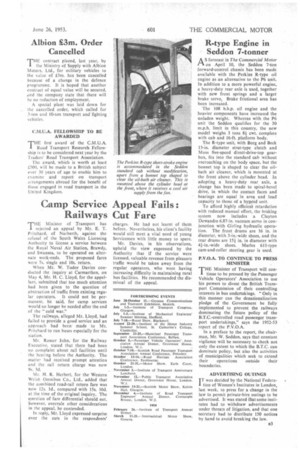R-type Engine in Seddon 7-tonner
Page 37

If you've noticed an error in this article please click here to report it so we can fix it.
AS forecast in The Commercial Motor on April IO, the Seddon 7-ton forward-control chassis has been made available with the Perkins R-type oil engine as an alternative to the P6 unit. In addition to a more powerful engine, a heavy-duty rear axle is used, together with new front springs and a larger brake servo. Brake frictional area has been increased.
The 108 b.h.p. oil engine and the heavier components have increased the
unladen weight. Whereas with the P6 Unit the Seddon qualifies for the 30 m.p.h. limit in this country, the new model weighs 3 Ions 8i. cwt, complete with cab and 16-ft. platform body.
The R-type unit, with Borg and Beck 13-in, diameter strut-type clutch and Moss five-speed direct-drive-top gear box, fits into the standard cab without encroaching on the body space, but the bonnet top is shaped to clear the oil
bath air cleaner, which is mounted at the front above the cylinder head. In adopting a heavy-duty rear axle, a change has been made to spiral-bevel drive, in which the contact faces and bearings are equal in area and load capacity to those of a hypoid unit.
To afford highly efficient retardation with reduced manual effort, the braking system now includes a Clayton Dewandre 6.87-in, vacuum servo in conjunction with Girling hydraulic opera tion. The front drums are 16 in. in diameter, with 3-in.-wide shoes, and the rear drums are 151 in. in diameter with 41-in.-wide shoes. Mart es 611-type cam-and-roller steering gear is used.
P.V.O.A. TO CONTINUE TO PRESS MINISTER
THE Minister of Transport will con tinue to be pressed by the Passenger Vehicle Operators' Association to use his powers to divest the British Transport Commission of then controlling interests in bus undertakings. "Only in this manner can the denationalization pledge of the Government be fully implemented to prevent the railways dominating the future policy of the B.T.C.-controlled road passenger transport undertakings," says the 1952-53 report of the P.V.O.A.
In a preface to the report, the chairman, Mr. W. Seddon, says that constant vigilance will be necessary to check not only the extent to which the B.T.C. can dominate policy, but also the activities of municipalities which seek to extend
their operations outside their boundaries.
ADVERTISING OUTINGS
IT was decided by the National Federation of Women's Institutes in London, last week, to press for a change in the law to permit private-hire outings to be advertised. It was stated that some institutes had to withdraw advertisements under threats of litigation, and that one secretary had to distribute 150 notices by hand to avoid breaking the law.




































































































